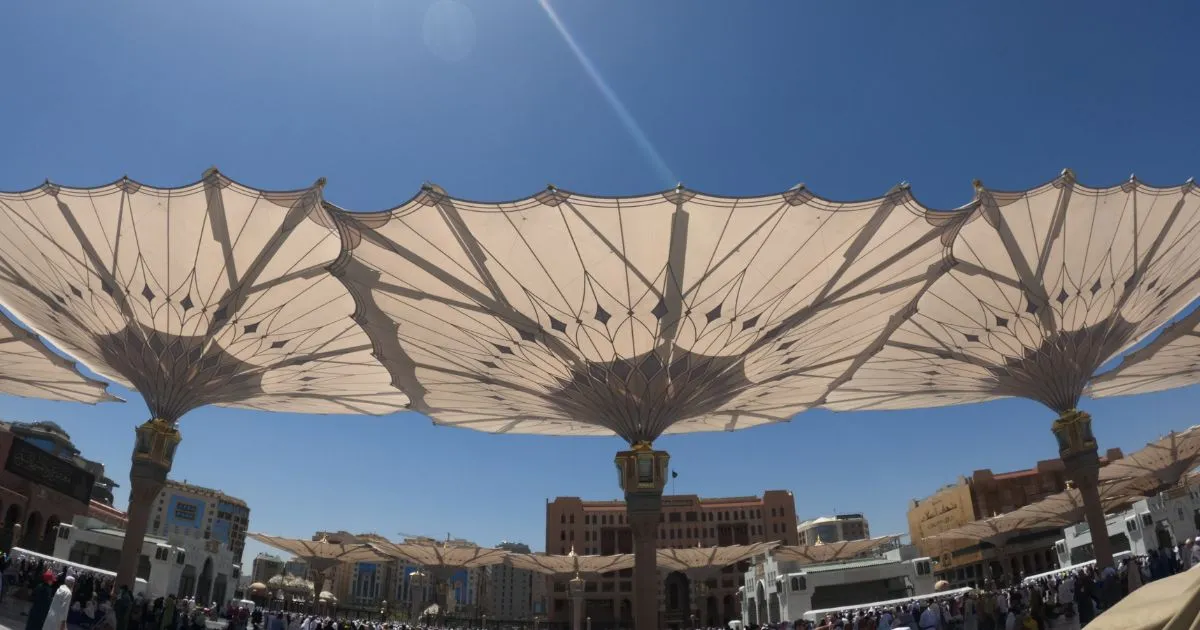The Sacred Boundaries of Madinah: Legal Rulings and Jurisprudential Implications
Table of Contents
The Sacred Boundaries of Madinah: Legal Rulings and Jurisprudential Implications
Primary Boundary Markers:
- Mount Thawr (Jabal Thawr) in the north
- Mount ‘Ayr (Jabal ‘Ayr) in the south
- The area between these two mountains forms the eastern and western boundaries
Northern Boundary
24.5800° N, 39.6120° E
(Near Jabal Thawr of Madinah – NOT Makkah’s Thawr)
Southern Boundary
24.4100° N, 39.6170° E
(Near Jabal ‘Ayr, south of Quba)
Eastern Boundary
24.4950° N, 39.7000° E
(Edge of Harrat al-Madinah lava fields)
Western Boundary
24.4950° N, 39.5330° E
(Near Wadi al-‘Aqeeq)
Key Facts About the Coordinates:
- Shape: Forms an irregular oval ~20km tall × 12.5km wide
- Sacred Center: Prophet’s Mosque at 24.4672° N, 39.6112° E
- Modern Markers: 329 boundary pillars placed by Saudi authorities
- Area: Approximately 225 km² (90% wilderness, 10% urban)
Important Notes:
- These coordinates reflect the minimum Haram area from hadith sources
- Some scholars include areas up to 5km beyond these points
- The Saudi government maintains buffer zones beyond the exact boundaries
Detailed Description:
- The Haram extends approximately 12 miles north-south (from Thawr to ‘Ayr)
- About 10 miles east-west at its widest point
- Includes the area between the two black volcanic tracts (Al-Harrah)
Key Locations Within the Haram:
- Quba Mosque (southern edge)
- Masjid al-Qiblatayn
- Mount Uhud (just outside northern boundary)
Modern Interpretation:
Contemporary scholars and Saudi authorities have marked these boundaries with:
- Road signs in Arabic and English
- Physical markers along major highways
- Digital mapping coordinates
The exact boundaries remain consistent with the Prophet’s original designation, though modern urban expansion has led to some administrative adjustments while maintaining the sacred status of the core area.
Several researchers who have studied the boundaries of Madinah’s sacred precinct (Haram) have emphasized the importance of this subject due to the jurisprudential rulings associated with it. In previous publications by Al-Madinah newspaper, they highlighted certain legal rulings specifically connected to Madinah’s sanctity.
Prohibition of Hunting and Cutting Trees
In the book “Al-Ahkam Al-Fiqhiyyah Al-Muta’alliqah bil-Madinah Al-Nabawiyyah“ by Sheikh Yusuf bin Matar Al-Muhammadi, the author examines several rulings that distinguish Madinah’s Haram from other regions. Among these are the prohibition of hunting and cutting trees within its boundaries—a position upheld by the majority of Malikis, Shafi’is, and Hanbalis.
They base their argument on the hadith of Jabir in Sahih Muslim, where the Prophet (peace be upon him) said:
“Indeed, Ibrahim declared Makkah sacred, and I declare Madinah sacred—what lies between its two lava fields. Its thorny trees should not be cut, and its game should not be hunted.”
Additionally, Muslim narrates from ‘Asim al-Ahwal that he asked Anas (may Allah be pleased with him): “Did the Messenger of Allah (peace be upon him) declare Madinah sacred?” Anas replied: “Yes, it is sacred. Its fresh herbage should not be uprooted, and whoever does so will incur the curse of Allah, the angels, and all people.”
Abu Huraira (may Allah be pleased with him) used to say: “If I saw gazelles in Madinah, I would not frighten them.”
Al-Muhammadi presents the majority’s evidence in full and refutes the Hanafi view, which denies the prohibition of hunting in Madinah’s Haram. He also discusses the legal consequences for killing game or cutting trees, favoring the opinion that the offender should be subjected to Salb (confiscation of possessions), an early Shafi’i view endorsed by Imam al-Nawawi. This is based on the Prophet’s (peace be upon him) ruling that whoever catches someone cutting trees in the Haram may seize their belongings.
Al-Muhammadi also supports the Shafi’i and Hanbali position that the offender’s possessions may be confiscated, citing the incident where Sa’d bin Abi Waqqas refused to return what the Prophet (peace be upon him) had granted him, saying: “I seek refuge in Allah from returning something the Messenger of Allah gave me.”
Additionally, Al-Muhammadi mentions that if a hunter or tree-cutter is not penalized with confiscation, they must repent and seek forgiveness.
Bringing Hunted Game into the Haram
Scholars have historically differed on whether game hunted outside the Haram can be brought inside. Al-Muhammadi supports the majority view permitting it, citing the hadith where the Prophet (peace be upon him) playfully asked Anas’s brother: “O Abu ‘Umayr, what happened to the little bird (Nughayr)?”—referring to a bird kept in Madinah.
Soil and Stones of the Haram
Al-Muhammadi states that it is disliked (makruh) to remove soil, pebbles, or stones from the Haram, drawing a parallel with Makkah’s sanctity.
The Protected Pasture (Hima) of Madinah
Beyond the Haram lies the Hima (protected pasture). The Shafi’is prohibit cutting fresh grass there, while Malikis restrict the prohibition to trees only.
Locusts in the Haram
Although locusts are generally permissible to hunt and eat, Al-Muhammadi advises against hunting them within the Haram, similar to Makkah’s sanctity. However, he does not endorse confiscation for hunting locusts, considering public ignorance of this ruling.
Residing in Madinah (Mujawarah)
Many Muslims aspire to reside in Madinah. Al-Muhammadi cites scholars who recommend this, including Imam Ahmad, who said: “It is the place of Hijrah for Muslims.” Abu Sa’id al-Khudri also advised a companion enduring hardship in Madinah to remain, recalling the Prophet’s supplication for its blessings.
Leaving Madinah
Al-Muhammadi divides those who leave Madinah into two categories:
- Those seeking cheaper living or comfort – They abandon great good, as the Prophet (peace be upon him) said: “A time will come when people will leave Madinah seeking prosperity, but Madinah will be better for them if only they knew.”
- Those leaving for necessity (trade, jihad, etc.) – This is not condemned.
Introducing Innovations or Oppression in Madinah
The Prophet (peace be upon him) warned:
“Whoever introduces an innovation (oppression) in Madinah or shelters an innovator will incur the curse of Allah, the angels, and all people.”
Additionally, he said:
“No one plots against the people of Madinah except that they will dissolve like salt in water.”
Dying in Madinah
Al-Muhammadi highlights the virtue of dying in Madinah, citing the Prophet’s (peace be upon him) saying:
“Whoever can die in Madinah, let them do so, for I will intercede for those who die there.”
He also permits transporting the deceased for burial in Madinah if feasible.
Houses Connected to the Haram
Residential areas extending into the Haram adopt its sanctity—oppression and evil intentions are prohibited, and dying there is akin to dying within the Haram. However, hunting and tree-cutting are not forbidden in these outer regions.
This comprehensive study by Al-Muhammadi underscores the unique legal and spiritual status of Madinah’s sacred boundaries.

